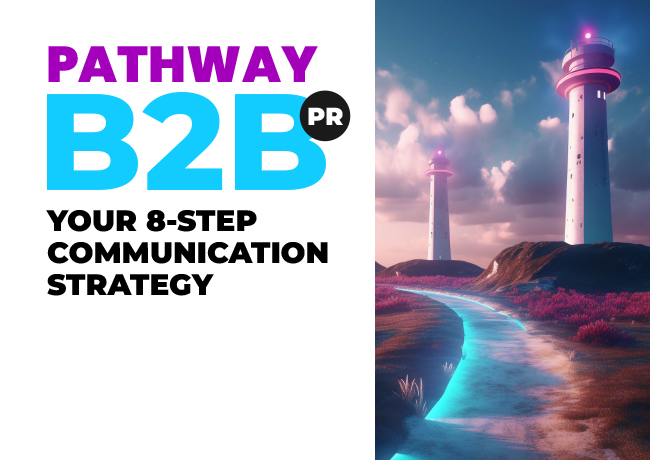
8 Key components for a powerful B2B PR strategy
In B2B marketing, a robust PR plan is essential for building credibility, nurturing relationships, and ultimately driving business growth. But first and foremost, you need to understand what B2B PR is and how it differs from B2C PR.
What is B2B PR how is it different to B2C PR?
B2B (business-to-business) and B2C (business-to-consumer) PR differ significantly in their approach, audience, and objectives. In B2B PR, the focus is on building long-term relationships with other businesses, often involving a smaller, more niche audience. The messaging is typically more detailed and technical, aiming to address specific business challenges and showcase industry expertise.
Conversely, B2C PR targets a broader consumer base with more emotive and broad-based messages designed to drive quick engagement and purchases. While B2C campaigns might leverage celebrity endorsements and viral content, B2B PR relies heavily on thought leadership, industry reports, and case studies to build credibility and trust over time.
What are the benefits of PR for B2B tech brands?
For B2B companies, PR plays a crucial role in establishing a strong market presence and driving business growth. One of the primary benefits is the enhancement of brand credibility and trust. Through consistent, high-quality media coverage and thought leadership, B2B companies can position themselves as industry leaders and reliable partners. This credibility attracts potential clients and strengthens relationships with existing ones.
Effective PR planning can also significantly improve lead generation and conversion rates. By aligning PR strategies with marketing efforts, B2B companies can reach their target audience more efficiently, create engaging content that addresses their specific needs, and ultimately influence their purchasing decisions. This integrated approach ensures that PR contributes directly to the company’s bottom line.
8 Components for a complete B2B PR strategy
The 8 key elements that contribute to a successful B2B PR strategy include:
1 Clear objective setting:
Define what success looks like. Are you aiming to increase brand awareness, generate leads, or establish thought leadership? Clear, measurable objectives will guide your strategy and allow you to track progress.
2 Define your target audience:
Know your audience inside out. Use psychographics as well as demographics to tailor your communications effectively. Read our article: 5 Steps to identifying your ideal target audience.
3Create strong messaging:
Develop a consistent and compelling narrative that resonates with your audience. Your message should address their needs and requirements at different stages of the buying process.
Thought leadership:
Position your brand as an industry expert. Publish insightful articles, whitepapers, and case studies that showcase your expertise and innovative solutions. Use speaking opportunities and webinars to share your knowledge and connect with industry peers.
Media relations:
Build and maintain relationships with key journalists and industry influencers. A proactive media outreach strategy ensures your brand stays in the spotlight. Regularly pitch story ideas that align with current industry trends and your brand’s expertise.
6 Content strategy:
Create a variety of high-quality content tailored to different stages of the buyer’s journey. From blog posts and press releases to videos and infographics, ensure your content is engaging and informative. Each piece should serve a specific purpose: raising awareness, educating potential clients, or converting leads.
Social media engagement:
Use social media platforms to amplify your message and engage your audience. Share your content, participate in relevant conversations, and use social listening tools to monitor industry trends and competitor activities.
Crisis management plan:
Prepare for potential PR crises with a well-defined response plan. Quick, transparent communication can mitigate damage and preserve your brand’s reputation. Ensure all team members are aware of the protocol and ready to act if necessary.
Measuring Results and continually improving performance
Measuring the success of B2B PR initiatives requires a multi-faceted approach, leveraging both quantitative and qualitative metrics. Key Performance Indicators (KPIs) such as media coverage, share of voice, website traffic, and lead generation are essential for assessing the reach and impact of PR campaigns. Tools like Google Analytics and media monitoring services can track these metrics effectively.
Additionally, evaluating engagement metrics—such as social media interactions, content downloads, and webinar attendance—provides insight into how well your audience responds to your efforts. Qualitative measures, including client feedback and sentiment analysis, offer a deeper understanding of your brand’s reputation and the effectiveness of your messaging. Combining these strategies ensures a comprehensive evaluation of PR performance and helps identify areas for improvement.
TL;DR: Unlocking success: the blueprint for a powerful B2B PR plan
In B2B marketing, a strong PR plan is vital for building credibility, nurturing relationships, and driving business growth. Key elements of a successful B2B PR strategy include setting clear objectives, understanding the target audience, developing strong messaging, positioning as a thought leader, maintaining media relations, crafting a robust content strategy, engaging on social media, and having a crisis management plan. Measuring success involves using both quantitative and qualitative metrics to ensure comprehensive evaluation and continuous improvement.

Your 8-Step Communication Strategy Guide
A comprehensive guide to delivering your business goals using intelligent and relevant messaging.
Our insights
Subscribe to our updates
Stay up to date with the latest insights, case studies and PR guides.

